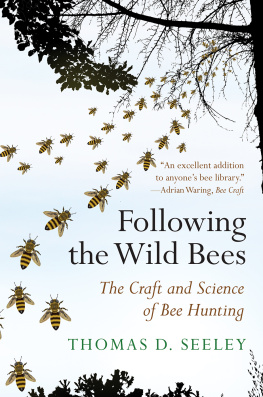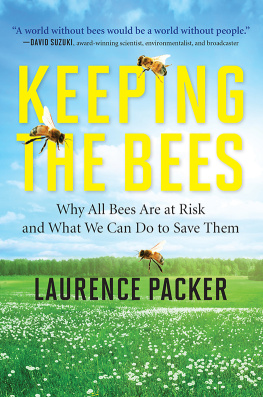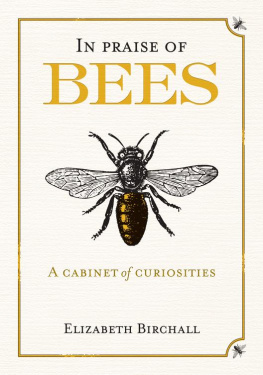Thomas D. Seeley - Following the Wild Bees
Here you can read online Thomas D. Seeley - Following the Wild Bees full text of the book (entire story) in english for free. Download pdf and epub, get meaning, cover and reviews about this ebook. year: 2016, publisher: Princeton University Press, genre: Home and family. Description of the work, (preface) as well as reviews are available. Best literature library LitArk.com created for fans of good reading and offers a wide selection of genres:
Romance novel
Science fiction
Adventure
Detective
Science
History
Home and family
Prose
Art
Politics
Computer
Non-fiction
Religion
Business
Children
Humor
Choose a favorite category and find really read worthwhile books. Enjoy immersion in the world of imagination, feel the emotions of the characters or learn something new for yourself, make an fascinating discovery.
- Book:Following the Wild Bees
- Author:
- Publisher:Princeton University Press
- Genre:
- Year:2016
- Rating:5 / 5
- Favourites:Add to favourites
- Your mark:
- 100
- 1
- 2
- 3
- 4
- 5
Following the Wild Bees: summary, description and annotation
We offer to read an annotation, description, summary or preface (depends on what the author of the book "Following the Wild Bees" wrote himself). If you haven't found the necessary information about the book — write in the comments, we will try to find it.
Following the Wild Bees — read online for free the complete book (whole text) full work
Below is the text of the book, divided by pages. System saving the place of the last page read, allows you to conveniently read the book "Following the Wild Bees" online for free, without having to search again every time where you left off. Put a bookmark, and you can go to the page where you finished reading at any time.
Font size:
Interval:
Bookmark:

Following the Wild Bees

Following the Wild Bees

The Craft and Science of Bee Hunting
THOMAS D. SEELEY
Design and photographic assistance by Megan E. Denver
Line drawings by Margaret C. Nelson
PRINCETON UNIVERSITY PRESS
PRINCETON AND OXFORD
Copyright 2016 by Princeton University Press
Published by Princeton University Press, 41 William Street, Princeton, New Jersey 08540
In the United Kingdom: Princeton University Press, 6 Oxford Street, Woodstock, Oxfordshire OX20 1TW
press.princeton.edu
Jacket photo by Jorik Phillips
All Rights Reserved
Library of Congress Cataloging-in-Publication Data
Names: Seeley, Thomas D., author.
Title: Following the wild bees : the craft and science of bee hunting / Thomas D. Seeley ; design and photographic assistance by Megan E. Denver ; line drawings by Margaret C. Nelson.
Description: Princeton : Princeton University Press, 2016. | Includes bibliographical references and index.
Identifiers : LCCN 2015038694 | ISBN 9780691170268
(hardcover: alk. paper)
Subjects: LCSH: Bee hunting.
Classification: LCC SF537 .S44 2016 | DDC 595.79/9dc23
LC record available at http://lccn.loc.gov/2015038694
British Library Cataloging-in-Publication Data is available
This book has been composed in Sabon
Printed on acid-free paper.
Printed in the United States of America
1 3 5 7 9 10 8 6 4 2
Dedicated to the honey bees living in the Arnot Forest

 Contents
Contents
 Preface
Preface
The popularity of honey bees has skyrocketed over the past decade, so now is a perfect time to provide a book on a second waybesides beekeepingfor people to have fun with these wonderful little creatures. Our subject is an open-air sport called bee hunting. Whereas the beekeeper manages colonies of honey bees that are living in hives he has provided, the bee hunter searches for colonies of honey bees that are living in tree cavities and other homesites they have selected. The bee hunter starts his search for a wild colony by catching bees on flowers and then baiting them to forage at a small bonanza of sugar syrup that he has bewitchingly scented with anise. Next he determines the direction to the bees secret residence from the paths of their homeward flights. Then he gradually moves his sugar-syrup feeder, together with the bees, down their flight line hometheir beeline. Finally, he zeroes in on their mysterious dwelling place: some hollow tree, old building, or abandoned hive.
This all sounds rather tricky, so you might be wondering, is bee hunting something that I can do? The answer is yes. Success in bee hunting, as in all the other truly fascinating games in the world, does not require complex equipment, but it does require some special skills. This book is a guide to acquiring the simple tools and learning the ingenious methods that compose the craft of the bee hunter. While bee hunting is not a trivially easy sport, it is one that any person who enjoys spending time in nature, has patience and determination, and thrills to a treasure hunt can master and enjoy.
Bee hunting, also known as bee lining, used to be practiced widely in Europe, North America, the Middle East, and Africa. Indeed, it may be a pursuit as old as humankind, for it is likely that early humans, living in hunter-gatherer groups, searched for nests of honey bees and robbed them of brood and honey for food, as do some of the hunter-gatherer peoples who have survived to the present time. Probably the earliest written description of the methods for finding the nest of a wild honey bee colony by lining bees is that of Columella, a Roman farm owner and writer on agriculture who lived in the first century A.D. In his book on the cultivation of bees, he gives delightfully detailed instructions for capturing bees at a spring, feeding them honey, and then releasing them one-by-one to trail them back to the lurking place of the swarm.
Within Europe, bee hunting was especially common in heavily forested regions, such as western Russia and Hungary, where it was a critical part of the craft of hollow-tree beekeeping. Forest beekeepers used various kinds of bee trapsfor example, a cow-horn with a movable door in a slot and a small aperture closed with a plugto catch one or more bees, have them load up on honey smeared inside the trap, and then release them one at a time and follow them back to their nest, usually in a hollow tree. The discoverer would carve his ownership mark in the trees bark, cut a door in the trees trunk to access the bees nest cavity, and periodically climb the tree and collect some honeycombs. Bee hunting was also popular in North America following the introduction of the honey bee from Europe in the early 1600s. North American bee hunters used the same methods for finding wild colonies as had been practiced in Europe for centuries, but they rarely made repeated harvests of the honey from the colonies they found. Instead, they usually felled the trees occupied by the bees (bee trees) and stole all their honeycombs, often killing the colony in the process.
In both Europe and North America, the importance of bee hunting gradually diminished from the 1500s to the 1900s as beekeeping with hives grouped in apiaries became increasingly common. At first, these hives were simply the hollow tree sections occupied by the bees; they were moved to the beekeepers living place, where they functioned as log hives. The swarms from these log hives might be housed in skeps (domed hives made of twisted straw) or simple box hives. In the late 1800s, beekeepers began keeping their bees in purpose-built hives with movable wooden frames that neatly hold the bees combs and make it possible for beekeepers to closely manage their colonies.
The invention of the movable-frame hive, along with the bee smoker, honey extractor, and other tools of modern beekeeping, has made it vastly easier for humans to get honey by keeping managed colonies in hives aggregated in apiaries rather than by hunting wild colonies in trees scattered over the landscape. So, these days, the successful bee hunter doesnt need to end his hunt by taking up the bee treecutting it down, opening it up with a sledge and wedges to expose the bees nest, and cutting out the combs filled with honey. Instead of lugging home pails filled with white-yellow honeycombs, he can bring back a sweet haul of a different sort: delightful memories of sitting in sunny fields, watching honey bees fly off from his feeding station as they begin their flights home, and following the bees down their aerial trails to discover their mysterious abode.
The bee hunter who leaves the bees unharmed will still have an intensely pleasurable outing. After all, hunting is one of the oldest human activities, and the passion to hunt wild animals must have been, until quite recently, an immensely valuable part of human nature. I certainly feel the thrill of pursuing prey when I go bee hunting. Indeed, after making numerous moves down a beeline, closing in on a colony of forest-dwelling bees, and finally spying the glitter of the bees wings as they dive inside their tree-cavity home, I always experience soaring feelings of success even triumph! Eventually, I will head back to my own home, no richer in honey than when I started the day, for I will leave behind an undamaged bee tree and an unmolested bee colony. The dizzying jubilation of the gotcha moment will have passed, but alongside the delicious lingering feeling of success there will hum a quieter but equally pleasurable feeling: the satisfaction of having done no harm to the bees.
Next pageFont size:
Interval:
Bookmark:
Similar books «Following the Wild Bees»
Look at similar books to Following the Wild Bees. We have selected literature similar in name and meaning in the hope of providing readers with more options to find new, interesting, not yet read works.
Discussion, reviews of the book Following the Wild Bees and just readers' own opinions. Leave your comments, write what you think about the work, its meaning or the main characters. Specify what exactly you liked and what you didn't like, and why you think so.








